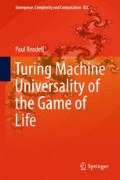Abstract
The background material is presented giving a description of Conway’s Game of Life, Turing machines and Counter Machines. The details of the rules for Game of Life are given along with the details of some of the most well known patterns. The operational cycle of a Turing machine is explained as well as an outline for a universal Turing machine. A simple Turing machine is presented while introducing the notation used to describe Turing machines in later chapters. Counter machines are described with an example instruction set and very simple program. Conway’s proof of the universality of the Game of Life is outlined with descriptions of the logical components he proposed.
Access this chapter
Tax calculation will be finalised at checkout
Purchases are for personal use only
References
Gardner, M.: Mathematical games: the fantastic combinations of John Conway’s new solitaire game ‘life’. Sci. Am. 223, 120–123 (1970)
Wolfram, S.: Universality and complexity in cellular automata. Physica 10D, 1–35 (1984)
Cook, M.: Universality in elementary cellular automata. Complex Syst. 15(1), 1–40 (2004)
Wolfram, S.: A New Kind of Science. Wolfram Media Inc., Champaign (2002)
Berlekamp, E., Conway, J., Guy, R.: What is life, chapter 25. Winning Ways for Your Mathematical Plays, vol. 2. Academic Press, London (1982)
Kleene, S.C.: Introduction to Metamathematics. North-Holland Publishing Company/Wolters-Noordhoff Publishing, Amsterdam (1952)
Turing, A.M.: On computable numbers, with applications to the Entscheidungs Problem. Proc. Lond. Math. Soc. 2, 230–265 (1937)
Minsky, M.L.: Computation: Finite and Infinite Machines. Prentice-Hall, Englewood Cliffs (1967)
Rogozhin, Y.: Small universal Turing machines. Theor. Comput. Sci. 168(2), 215–240 (1996). ISSN 0304-3975
Rendell, P.: A simple universal Turing machine for the game of life Turing machine, chapter 26. In: Adamatzky, A. (ed.) Game of Life Cellular Automata, pp. 519–545. Springer, London (2010)
Britton, S.: Java Applet Turing Machine Simulator. http://ironphoenix.org/tril/tm/ (2009)
Moore, C., Mertens, S.: The Nature of Computation. Oxford University Press, Oxford (2011)
Author information
Authors and Affiliations
Corresponding author
Rights and permissions
Copyright information
© 2016 Springer International Publishing Switzerland
About this chapter
Cite this chapter
Rendell, P. (2016). Background. In: Turing Machine Universality of the Game of Life. Emergence, Complexity and Computation, vol 18. Springer, Cham. https://doi.org/10.1007/978-3-319-19842-2_2
Download citation
DOI: https://doi.org/10.1007/978-3-319-19842-2_2
Published:
Publisher Name: Springer, Cham
Print ISBN: 978-3-319-19841-5
Online ISBN: 978-3-319-19842-2
eBook Packages: EngineeringEngineering (R0)

